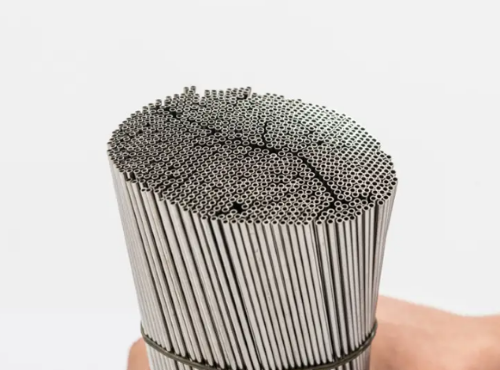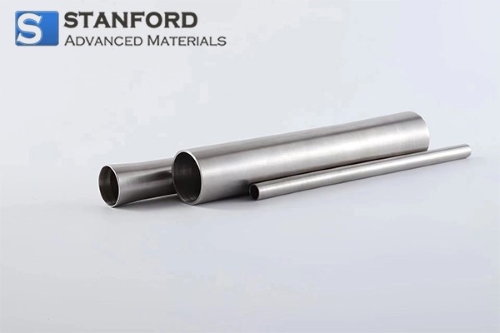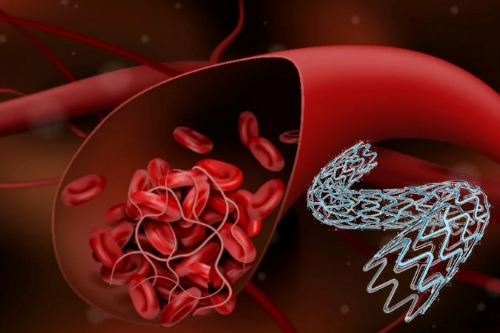Tubes capillaires : Types et applications
Les tubes capillaires sont de petits tubes minces avec un diamètre interne étroit qui jouent un rôle essentiel dans diverses applications scientifiques, industrielles et médicales. Ils sont largement utilisés dans des domaines tels que la mécanique des fluides, la mesure de la température, la chromatographie et la réfrigération. Voyons quels sont ses types, ses avantages et ses diverses applications.

Qu'est-ce qu'un tube capillaire ?
Les tubes capillaires sont des tubes à paroi mince dont le diamètre interne varie de quelques micromètres à quelques millimètres. Ces tubes sont généralement fabriqués à partir de matériaux tels que le verre, l'acier inoxydable ou le plastique, en fonction de l'application. Leur caractéristique principale est leur capacité à présenter une action capillaire, un phénomène par lequel les liquides montent dans un tube étroit en raison de la tension superficielle. Les tubes capillaires sont donc utiles dans les applications nécessitant un mouvement de fluide ou la mesure de petits volumes de liquide.
L'action capillaire se produit en raison de l'interaction entre le liquide et la surface du tube. Lorsque le liquide est aspiré dans l'espace étroit, il adhère aux parois du tube, tandis que la tension superficielle du liquide le fait monter contre la gravité. Cet effet est crucial dans de nombreux appareils et systèmes qui dépendent de l'écoulement précis de liquides. Voici une illustration de l'action capillaire, montrant comment un liquide interagit avec une surface polaire comme le verre (≡Si-OH).
 [1]
[1]
Avantages et bénéfices
- Précision dans le mouvement des fluides: Les tubes capillaires sont idéaux pour les applications qui nécessitent un contrôle précis du mouvement des liquides. Leur petit diamètre interne leur permet de déplacer des fluides en petites quantités précises.
- Pas besoin d'alimentation externe: L'un des principaux avantages des tubes capillaires est qu'ils fonctionnent grâce à des forces physiques naturelles, telles que la tension superficielle et l'action capillaire. Cela signifie qu'ils n'ont pas besoin de sources d'énergie externes telles que des pompes ou des moteurs pour déplacer les liquides.
- Faible coût: Ces tubes sont relativement peu coûteux à fabriquer, en particulier ceux en verre. Leur faible coût en fait une solution attrayante pour de nombreuses industries où la précision est nécessaire sans avoir recours à des machines complexes.
- Conception compacte: En raison de leur petite taille, ces tubes sont idéaux pour les applications où l'espace est restreint ou lorsque des quantités minimales de liquide sont requises. Leur compacité permet de les intégrer facilement dans de petits systèmes ou dispositifs.
- Polyvalence: Les tubes capillaires sont disponibles dans différents matériaux tels que le verre, l'acier inoxydable et le plastique, ce qui permet de les utiliser dans un large éventail d'environnements, y compris les environnements à haute température ou corrosifs.
Types de matériaux des tubes capillaires
Les tubes capillaires sont disponibles en différents matériaux, tailles et modèles, chacun étant adapté à des applications spécifiques. Les types les plus courants sont les suivants
1. Tubes capillaires en verre
Les tubes capillaires en verre sont les plus courants et sont généralement utilisés en laboratoire. Ils sont transparents, ce qui permet d'observer facilement le liquide qu'ils contiennent. Les tubes en verre sont idéaux pour les applications où la visibilité est importante, par exemple lors du suivi du mouvement des fluides dans les expériences. Ils sont également chimiquement inertes, ce qui les rend adaptés à une large gamme d'applications chimiques.
Applications: Utilisés pour mesurer la température, comme dans les thermomètres, et dans les expériences de laboratoire où le comportement des fluides doit être étudié.
2. Tubes capillaires en acier inoxydable
Les tubes capillaires en acier inoxydable sont utilisés dans des applications industrielles plus exigeantes où la durabilité et la résistance à la corrosion sont cruciales. Ces tubes sont idéaux pour les applications impliquant des systèmes à haute pression ou des produits chimiques agressifs. Leur résistance mécanique les rend aptes à manipuler des liquides sous pression, en particulier dans les systèmes qui requièrent de la précision.

Applications: Couramment utilisés dans les systèmes de réfrigération, les systèmes hydrauliques et les appareils médicaux.
3. Tubes capillaires en plastique
Les tubes capillaires en plastique, fabriqués à partir de matériaux tels que le polycarbonate ou le téflon, sont légers et résistants aux produits chimiques. Ils sont flexibles et peuvent être moulés dans différentes formes, ce qui les rend adaptables à différentes applications. Les tubes en plastique sont souvent utilisés dans des applications moins exigeantes où le coût et le poids sont des facteurs importants.
Applications: Utilisés dans les produits de consommation, les appareils médicaux et divers systèmes de gestion des fluides.
4. Tubes capillaires bimétalliques
Les tubes capillaires bimétalliques sont composés de deux métaux différents, généralement liés ensemble. Ces tubes sont principalement utilisés dans les applications de détection de la température, car les deux métaux se dilatent à des vitesses différentes, ce qui leur permet d'agir comme un commutateur sensible à la température.
Applications: Largement utilisés dans les thermostats et les systèmes de réfrigération pour réguler la température.
Applications des tubes capillaires
Les tubes capillaires sont utilisés dans un large éventail de secteurs, de la recherche scientifique aux processus industriels. Voici quelques-unes de leurs applications les plus remarquables :
1. Systèmes de réfrigération
Dans le domaine de la réfrigération, les tubes capillaires sont un élément essentiel du système de détendeur. Le capillaire contrôle le flux de réfrigérant du côté haute pression au côté basse pression du système. La pression du fluide frigorigène est réduite lorsqu'il passe dans le tube étroit, ce qui provoque sa dilatation et son refroidissement, d'où l'effet de réfrigération. Cette application est courante dans les unités de climatisation et de réfrigération.
2. Thermomètres
Ils sont utilisés dans les thermomètres à liquide dans le verre, où le tube capillaire contient un liquide (généralement du mercure ou de l'alcool) qui se dilate ou se contracte en fonction des changements de température. Lorsque la température augmente, le liquide contenu dans le tube remonte, ce qui permet d'obtenir des relevés de température précis. Les tubes capillaires permettent d'effectuer des mesures précises, même en cas de très faibles variations de température.
3. Chromatographie
Dans les techniques chromatographiques, les tubes capillaires sont utilisés dans la chromatographie sur couche mince (TLC ) ou la chromatographie en phase gazeuse (GC). Ces tubes permettent une séparation précise des substances en utilisant l'action capillaire pour déplacer les solvants à travers une phase stationnaire. Cette technique est largement utilisée en analyse chimique pour identifier et quantifier les différents composants d'un échantillon.
4. Études sur l'écoulement des fluides
Les tubes capillaires sont souvent utilisés dans les laboratoires pour étudier le comportement des fluides dans des conditions contrôlées. En mesurant la distance parcourue par un liquide dans un tube capillaire, les chercheurs peuvent déterminer des propriétés importantes telles que la tension superficielle et la viscosité. Ces études sont fondamentales dans des domaines tels que la physique, la chimie et la biologie.
5. Dispositifs médicaux
Dans les applications médicales, les tubes capillaires sont utilisés dans des dispositifs tels que les tubes de prélèvement sanguin et les équipements de prélèvement sanguin capillaire. Leur petite taille permet de prélever de très petits volumes de sang ou d'autres fluides corporels, ce qui est crucial pour les tests de diagnostic. Les tubes capillaires sont également utilisés dans certains types de thermomètres médicaux.
6. Systèmes hydrauliques
Les tubes capillaires en acier inoxydable sont utilisés dans les systèmes hydrauliques où ils aident à contrôler le flux de fluide dans des environnements à haute pression. Ces tubes sont essentiels pour réguler le flux d'huile ou d'autres fluides dans les machines, assurant ainsi un fonctionnement souple et efficace.
7. Mèche et mouvement des fluides
Les tubes capillaires sont également utilisés dans les applications de mèche, où ils facilitent le mouvement des liquides à travers les surfaces. Cela est particulièrement utile pour absorber les liquides dans certains processus industriels ou dans la construction de dispositifs tels que les stylos à encre, où l'action capillaire aide à attirer l'encre vers la pointe d'écriture.
Conclusion
Les tubes capillaires peuvent contrôler avec précision le mouvement des fluides sans nécessiter d'énergie externe, ce qui les rend inestimables dans les systèmes de réfrigération, la mesure de la température, la chromatographie et les appareils médicaux.
Stanford Advanced Materials (SAM) est compétent pour fournir des tubes capillaires d'une grande pureté et à des prix compétitifs, notamment en acier inoxydable, en alliages à base de nickel et en métaux précieux. Qu'ils soient destinés à des usages industriels, scientifiques ou médicaux, les tubes capillaires de SAM sont conçus pour répondre aux besoins spécifiques de chaque client.
Référence :
[1] Action capillaire. (2024, 30 décembre). Dans Wikipedia. https://en.wikipedia.org/wiki/Capillary_action#




